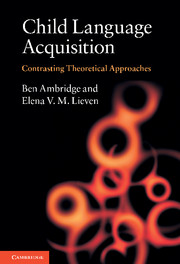Book contents
- Frontmatter
- Contents
- List of figures
- List of tables
- List of boxes
- List of summary tables
- Preface
- Acknowledgements
- 1 Introduction
- 2 Speech perception, segmentation and production
- 3 Learning word meanings
- 4 Theoretical approaches to grammar acquisition
- 5 Inflection
- 6 Simple syntax
- 7 Movement and complex syntax
- 8 Binding, quantification and control
- 9 Related debates and conclusions
- Notes
- References
- Author index
- Subject index
1 - Introduction
Published online by Cambridge University Press: 05 June 2012
- Frontmatter
- Contents
- List of figures
- List of tables
- List of boxes
- List of summary tables
- Preface
- Acknowledgements
- 1 Introduction
- 2 Speech perception, segmentation and production
- 3 Learning word meanings
- 4 Theoretical approaches to grammar acquisition
- 5 Inflection
- 6 Simple syntax
- 7 Movement and complex syntax
- 8 Binding, quantification and control
- 9 Related debates and conclusions
- Notes
- References
- Author index
- Subject index
Summary
In this introductory chapter, we briefly outline (1) the major theoretical approaches to child language acquisition research, (2) the domains and debates to be covered in the rest of the book and (3) the major methodological paradigms used in the field.
The major theoretical approaches
Although there are a few exceptions, for the majority of the debates that we will encounter in this book, each of the competing proposals will generally be aligned with one of the two major theoretical approaches to language acquisition. These are (a) the nativist, generativist, Universal Grammar (UG) approach and (b) the constructivist, emergentist, socio-pragmatic, functionalist, usage-based approach. As outlined below, which terms are most appropriate depends on the precise nature of each proposal, and the domain under investigation.
Nativist/generativist/Universal Grammar (UG) proposals
A theoretical proposal that is nativist assumes that some important aspects of children's linguistic knowledge are not acquired, but innate (present from birth and, for at least some researchers, encoded in the genome).
A theoretical proposal that is generativist assumes that children's knowledge of grammar (encompassing syntax, inflectional morphology and, in some approaches, phonology) consists of knowledge of formal ‘rules’ or operations that operate on abstract linguistic categories (e.g. VERB, NOUN) and phrases (e.g. VERB PHRASE, NOUN PHRASE). For example, oversimplifying somewhat, one operation for forming an English sentence combines a NOUN (e.g. John) and a VERB (e.g. danced) in that order (e.g. John danced not Danced John). This is an example of a syntactic operation (a ‘rule’ of syntax; see Chapters 4 and 6). An example of a morphological operation (a ‘rule’ of inflectional morphology) is the process by which the past-tense -ed inflectional morpheme is added to a regular English VERB (e.g. kiss → kissed; see Chapters 4 and 5).
[…]
- Type
- Chapter
- Information
- Child Language AcquisitionContrasting Theoretical Approaches, pp. 1 - 12Publisher: Cambridge University PressPrint publication year: 2011



